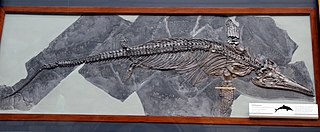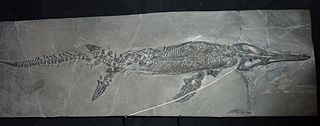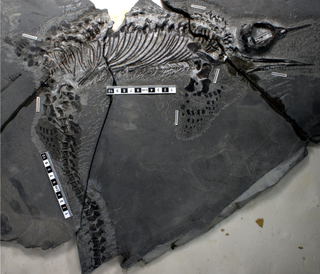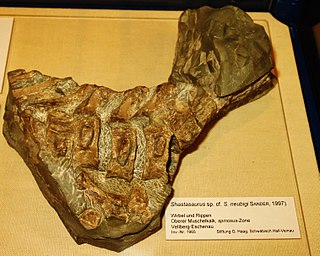
Ichthyosaurus is a genus of ichthyosaurs from the Early Jurassic, with possible Late Triassic record, from Europe. It is among the best known ichthyosaur genera, as it is the type genus of the order Ichthyosauria.

Temnodontosaurus is an extinct genus of ichthyosaur from the Early Jurassic period. They lived between 200 and 175 million years ago (Hettangian-Toarcian) in what is now Western Europe and possibly Chile. It lived in the deeper areas of the open ocean. University of Bristol paleontologist Jeremy Martin described the genus Temnodontosaurus as "one of the most ecologically disparate genera of ichthyosaurs," although the number of valid Temnodontosaurus species has varied over the years.

Mixosaurus is an extinct genus of Middle Triassic ichthyosaur. Its fossils have been found near the Italy–Switzerland border and in South China.

Stenopterygius is an extinct genus of thunnosaur ichthyosaur known from Europe.

Chaohusaurus is an extinct genus of basal ichthyopterygian, depending on definition possibly ichthyosaur, from the Early Triassic of Chaohu and Yuanan, China.

Excalibosaurus is a monotypic genus of marine prehistoric reptiles (ichthyosaurs) that lived during the Sinemurian stage of the Early Jurassic period in what is now England. It is characterized by the extreme elongation of the rostrum, with the lower jaw about three-fourths of the length of the upper jaw, giving the animal a swordfish-like look. The only known species is Excalibosaurus costini.

Shastasaurus is an extinct genus of very large ichthyosaur from the middle and late Triassic, and is the largest known marine reptile. Specimens have been found in the United States, Canada, and China.

Undorosaurus is an extinct genus of ophthalmosaurid ichthyosaur known from western Russia, Svalbard, and Poland. It was a large ichthyosaur, with the type species measuring 4–6 metres (13–20 ft) long and weighing 300 kilograms (660 lb).
Mollesaurus is an extinct genus of large ophthalmosaurine ophthalmosaurid ichthyosaur known from northwestern Patagonia of Argentina.
Callawayia is an extinct genus of ichthyosaur. It contains the species Callawayia neoscapularis.

Hudsonelpidia is an extinct genus of small parvipelvian ichthyosaur known from British Columbia of Canada.

Parvinatator, from Latin, “parvus” little and “natator” swimmer, is an extinct genus of small ichthyopterygian marine reptile that lived during the Early to Middle Triassic. Its fossils have been found in British Columbia, Canada.

Phantomosaurus is an extinct genus of ichthyosaur that lived during the late Anisian stage of the Middle Triassic. Fossils have been found in southern Germany. It was discovered in 1965 and named in 1997 as a species of Shastasaurus by Sander in the rocks of the Upper Muschelkalk.

Phalarodon is an extinct genus of mixosaurid ichthyosaur known from the Middle Triassic. Its name is derived from the Greek φᾰ́λᾰρον (phálaron) ("boss") and the Latin dens ("tooth). The genus has had a tumultuous history since its classification in 1910, with different workers describing species under different genera or declaring the genus to be a nomen dubium. Currently three species are recognized, but more have been identified in the past.

Thaisaurus is an extinct genus of ichthyopterygian marine reptile that lived during the Spathian. Fossils have been found in Thailand.
Wimanius is a mixosaurian ichthyosaur, and the only genus in the family Wimaniidae. It existed during the Triassic Period in what is now Switzerland. It was described by Maisch and Matzke in 1998 based on fossils found in the Monte San Giorgio Formation, and the type species is Wimanius odontopalatus. It was a small ichthyosaur, measuring 1 m (3.3 ft) long and weighing 4 kg (8.8 lb).
Macgowania is an extinct genus of parvipelvian ichthyosaur known from British Columbia of Canada.

Parvipelvia is an extinct clade of euichthyosaur ichthyosaurs that existed from the Late Triassic to the early Late Cretaceous of Asia, Australia, Europe, North America and South America. Named by Ryosuke Motani, in 1999, it contains the basal taxa like Macgowania and Hudsonelpidia. Maisch and Matzke (2000) found in their analysis seven synapomorphies that support Parvipelvia. They also found 10 synapomorphies that support the existence of post-Triassic clade of ichthyosaurs, for which the name Neoichthyosauria was found to be available. Parvipelvians were the only ichthyosaurs to survive the Triassic-Jurassic extinction event.

Pachygonosaurus is a genus of ichthyosaur from Upper Silesia, Poland. It was described in 1916 by Friedrich von Huene and it has one single species, Pachygonosaurus robustus, based solely on the holotype, composed of two vertebral centra discovered in 1910, with a further three vertebrae also possibly belonging to the genus. Nowadays, Pachygonosaurus is considered a nomen dubium.
Magnipterygius is an extinct genus of primitive ichthyosaur found in the Early Jurassic Posidonia Shale of Dotternhausen, Germany. The holotype specimen is SMNS96922, a nearly complete articulated skeleton. This genus is well known as a small-sized Ichthyosaur, of around 120 cm length, making it the second genus of that size after the Triassic. Due to the similarities with the genus Stenopterygius it has been classified as a member of the family Stenopterygiidae.






















